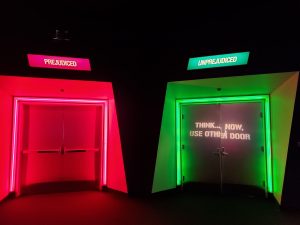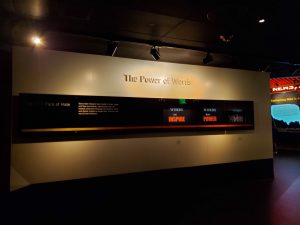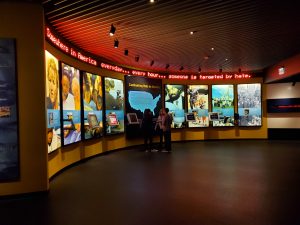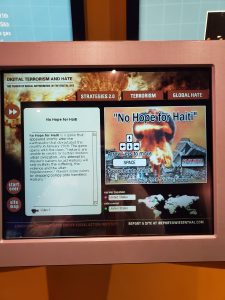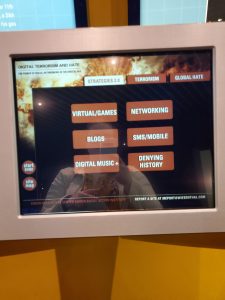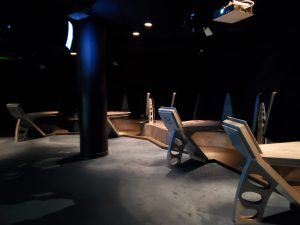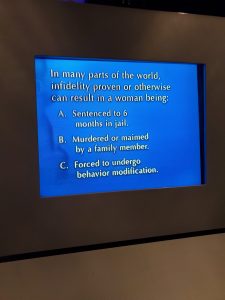Tolerancenter
The Tolerancenter focuses on the major issues of intolerance that happen in this country. When walking into the exhibit, one is met with two doors in which to go through. One door says prejudiced while the other says unprejudiced and one must decide which one they believe they are:
After the doors shut, a television is blaring awful hate speech such as “condoning the KKK” and “God hates Fags” and “Kill all the N*****” which is then followed by a mural on the wall called “Power of Words” describing how hate speech turns to hate symbols to hate gatherings to violence to terrorism:
After that, there numerous examples of this “Power of Words.” For example, the incident with Mathew Sheperd, the teen who was killed for being gay. Also, Balbir Sodhi was killed for looking like a Muslim after 9/11, but he was actually Sikh. James Byrd Jr was attacked and dragged behind a truck by three white nationalists:
Within in the same section, there is something called “GlobalHate.com” which is an interactive computer system that displays how hate has grown in the technologically-enhanced 21st century. For example, there was a video game called No Hope for Haiti. The goal of the game is to drop bombs on Haiti, since they are a poor country and no one will care if its inhabitants are killed. The more bombs dropped, the more points one receives. Another example is hate music, hate speech riddled blogs, and history deniers. All of these came into existence during the 21st century. I saw a blog dedicated to denying the Holocaust, a teaching program for Muslim children to believe in the Jihad against America, and Anti-Black country music:
The two sections in the exhibit that I found the most intriguing were the Point of View Diner and the Millennium Machine. The Point of View diner is a replica of a 1950’s diner that serves a menu of controversial topics such as hate speech, bullying, drunk driving, and sexual harassment. On your own personal viewing screen, you will hear actors talking in the video about one the mentioned topics and as the viewer, you choose whether or not you agree with what you hear and if not, why you believe it is a problem. Then you discuss why it is a problem and ways to end the problem:
The Millennium Machine is an interactive discussion on people who constantly come in contact with intolerance. There are three categories: women, POC, and refugees. During each category, it asks several questions to the audience and they have to buzz in their answers. Then after each question it shows on the screen how many people voted for each answer. One of the questions about women asked, “Do you agree that honor killings are justified if a woman cheats on her husband?” Then it gave examples are which countries allow them, including the Middle East, China, and Sweden. Every once in a while, it would put a question on the screen and have the audience discuss with one another whether or not they agree with what it asks:
This museum is a first of its kind and I love how it executed its purpose. The use of interactive technology to show the intolerance in the world is refreshing; this is especially useful for young teens to curb boredom and to excite visitors with easy and new ways to learn. However, many of the sections in the museum were a little outdated, so more current situations, scenarios, and examples are needed. Otherwise, everything about this exhibit was flawless.
